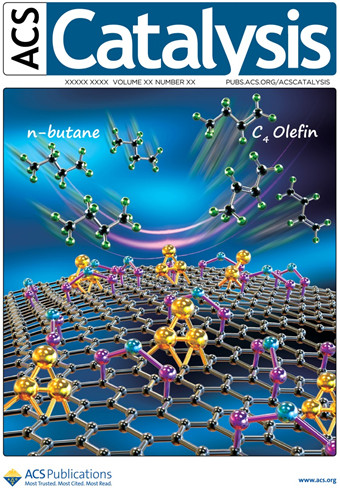Researchers Report a Tin Assisted Fully Exposed Platinum Clusters Stabilized on Defect-Rich Graphene for Dehydrogenation Reaction
Associate Prof. LIU Hongyang and his team from Institute of Metal Research, Chinese Academy of Sciences (IMR, CAS) recently reported a Tin assisted fully exposed Pt clusters are fabricated on the core-shell nanodiamond@graphene (ND@G) hybrid support for dehydrogenation reaction.
ACS Catalysis published this work online as the cover (DOI: 10.1021/acscatal.9b00601).
Light olefins, a widely used feedstock, are important building blocks for the synthesis of polymers and other value-added chemicals. Direct dehydrogenation (DDH) of light alkane is a typically industrial process for production of olefin which is an endothermic reaction thus requires high temperatures to obtain satisfactory conversion rates and olefin yields.
However, DDH could also lead to serious catalyst deactivation by sintering of active sites and coking at high reaction temperatures. To date, Pt3Sn alloy catalyst (Pt3Sn/Al2O3) is widely recognized as one of the best catalysts for this reaction, but rapid deactivation is still a main problem because the sintering of Pt3Sn nanoparticles (NPs) is unavoidable during dehydrogenation process.
Meanwhile, only the surface Pt atoms in Pt3Sn NPs can participate in the catalytic reaction which is uneconomical for Pt utilization.
Therefore, developing a better dispersed and more stabilized Pt-based catalyst is pivotal for the DDH of alkanes.
Associate Prof. LIU and his colleagues are dedicated to develop new nano-carbon materical supported metal catalysts.
They firstly reported the Pt-Sn catalyst with unique Pt species, fully exposed Pt clusters anchoring over the ND@G support (a-PtSn/ND@G). They use aberration-corrected transmission electron microscopy and X-ray adsorption fine structure (XAFS) spectra constructed the structures of three Pt atoms anchored on ND@G. The as-synthesized a-PtSn/ND@G catalyst shows excellent catalytic performance in DDH of n-butane at a relatively low temperature.
Also, they built the catalyst structures and studied the reaction mechanism by quuantum chemistry simulation at the DFT level. The atomically dispersed Pt clusters has guaranteed a full metal availability to the reactants, a high thermal stability as well as an optimized adsorption/desorption behavior.
This work paves the way for rational design of highly activity catalysts for dehydrogenation.

Journal cover (Image by ACS Catalysis)
Contact
HUANG Chengyu
E-mail:cyhuang@imr.ac.cn